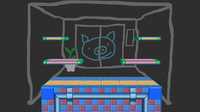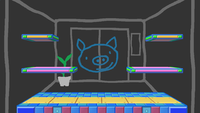WarioWare, Inc. (stage)
WarioWare, Inc. is a stage in the Super Smash Bros. series. It is based on the interior of the Variety Tower used for the Easy mode in WarioWare, Inc.: Mega Microgame$!, though it takes elements from WarioWare: Twisted! and WarioWare: Touched!. It first appears in Super Smash Bros. Brawl, then returns Super Smash Bros. for Nintendo 3DS and Super Smash Bros. Ultimate. In Super Smash Bros. Brawl and Super Smash Bros. Ultimate the stage is available by default, while in Super Smash Bros. for Nintendo 3DS the stage unlocks once Wario is unlocked, and is also the stage where the unlock battle for Wario takes place. The stage normally takes place inside the tower's elevator. Standard gameplay on this stage is occasionally interrupted by microgames, which pull the fighters through the elevator door into a separate area and in which players can take particular kinds of actions within the microgame's short time frame to win them. After a microgame, the fighters are returned to the elevator, and the winners are rewarded with item effects. However, players can still attack and KO each other during microgames, so a microgame starting does not necessarily stop the battle.
In the elevator, the stage consists of a large rectangular block extending from the bottom of the screen and four platforms floating above it. The block has a blue and pink checkered pattern on the front but a green and blue checkered pattern on its other sides. The portion of the top side of the block that is aligned with stage's main plane has large square yellow panels. The two platforms on the left consist of a lower purple medium length platform and a higher but shorter yellow platform, both aligned to match the left edge of the large block. Thee leftmost and rightmost portions of each platform is green instead of the normal color, and the platforms also have blue edges. The two platforms on right mirror the two platforms on the left. The background, depicting the elevator's interior, is done with reverse coloring and a blue outline of a pig on the door. The background has uneven linework as though a child drew it, and the lines wobble constantly.
When a microgame starts, the elevator door opens and pulls all of the fighters, items, and and objects through to the microgame's location. Every microgame has the same kind of terrain: flat ground that extends all the way to the edges of the screen. There are nine different microgames, seven of which are direct translations of the microgame into Super Smash Bros. gameplay. Those seven microgames are: Arrow Space, Blowin' Up, Crack Down, Crazy Cars, Kitty Cover, Lose Your Marble and Sole Man. Two others are unique to this stage: one whose command is "Don't move!" which appears to be based on Fragile!, and another whose command is "Taunt!" that does not appear to be based on any microgame. Each microgame has a different visual style, setting, and rules, just as they do in WarioWare, Inc.: Mega Microgame$!. They all start with a one or two word command which indicates the objective. Microgames all last for a short time, indicated by the gradually shrinking fuse of the bomb shown below the ground in the microgame. The microgame ends when the fuse runs out and the bomb explodes. Afterward the fighters, items, and and objects are brought back from the microgame into the platform on the elevator. Fighters who did not succeed in the microgame will have a briefly have a blue "X" appear over them, and fighters who did succeed in the microgame will have a briefly have a red "O" appear over them. The latter fighters are rewarded by being healed, growing big, or becoming temporarily invincible. In Super Smash Bros. Ultimate, becoming metallic is an additional kind of result.
Sometimes, when a microgame ends, instead of returning to the large block and its platforms, the game only goes to the elevator's interior. The terrain of this version of the stage is also flat ground that extends all the way to the edges of the screen and the main plane of this version is closer to the background than the version with the block and platforms. When this happens, another microgame will occur very quickly. The game can go to this version of the stage instead of the version with the block and platforms up to two times in a row, meaning there is a maximum of three consecutive microgames before the stage returns to normal.
The Ω form variation of the stage in Super Smash Bros. for Nintendo 3DS consists of just the base platform, though it has been raised and extended.
Songs[edit]
Super Smash Bros. Brawl[edit]
| Name | Source | Credits | Requirements |
|---|---|---|---|
| WarioWare, Inc. | WarioWare, Inc.: Mega Microgame$! | Arrangement Supervisor: Keigo Ozaki Composer: Nintendo Arranger: GAME ARTS Co., Ltd. |
Default |
| WarioWare, Inc. Medley | WarioWare, Inc.: Mega Microgame$! | Arrangement Supervisor: Ryoji Yoshitomi Composer: Nintendo Arranger: Nintendo |
Default |
| Ashley's Song | WarioWare: Touched! | Arrangement: Tomoko Sasaki Vocals: Emily McIntosh, Terry Lauber, James Cowan Composer: Nintendo |
Default |
| Ashley's Song (JP) | Sawaru Meido in Wario | Arrangement: Tomoko Sasaki Vocals: Tomoko Sasaki and the Small Circle of Friends Composer: Nintendo |
Default |
| Mike's Song | WarioWare: Touched! | Arrangement: Masafumi Takada Vocals: Terry Lauber, James Cowan Composer: Nintendo |
Grab CD |
| Mike's Song (JP) | Sawaru Meido in Wario | Arrangement: Masafumi Takada Vocals: Jun Fukuda and ghm sound team Composer: Nintendo |
Grab CD |
| Mona Pizza's Song | WarioWare: Twisted! | Arrangement Supervisor: Takahiro Nishi Vocals: Christina Peyser, Nate Bihldorff, Andy Hartpence Composer: INTELLIGENT SYSTEMS Arranger: GAME ARTS Co., Ltd. |
Default |
| Mona Pizza's Song (JP) | Mawaru Meido in Wario | Arrangement Supervicor: Takahiro Nishi Vocals: Gakkie & Kubocci Composer: INTELLIGENT SYSTEMS Arranger: GAME ARTS Co., Ltd. |
Default |
Super Smash Bros. for Nintendo 3DS[edit]
| Name | Source | Credits |
|---|---|---|
| WarioWare, Inc. | WarioWare, Inc.: Mega Microgame$ | Arrangement Supervisor: Keigo Ozaki Composition: Nintendo Arrangement: GAME ARTS Co., Ltd. |
| Ashley's Song (exclusive to American and European version) | WarioWare: Touched! | Arrangement: Tomoko Sasaki Vocals: Emily McIntosh, Terry Lauber, James Cowan Composition: Nintendo |
| Ashley's Song (JP) (exclusive to Japanese version) | WarioWare: Touched! | Arrangement: Tomoko Sasaki Vocals: Tomoko Sasaki and the Small Circle of Friends Composition: Nintendo |
Gallery[edit]
Names in other languages[edit]
| Language | Name | Meaning | Notes |
|---|---|---|---|
| Japanese | メイド イン ワリオ[?] Meido in Wario |
Made in Wario | |
| Chinese (simplified) | 瓦力欧制造[?] Wǎlì'ōu zhìzào |
Made in Wario | |
| Chinese (traditional) | WarioWare, Inc.[?] | WarioWare, Inc. | |
| Dutch | WarioWare, Inc.[?] | - | |
| French | WarioWare, Inc.[?] | - | |
| German | WarioWare, Inc.[?] | - | |
| Italian | WarioWare, Inc.[?] | - | |
| Korean | 메이드 인 와리오[?] Meideu in Wario |
Made in Wario | |
| Portuguese | WarioWare, Inc.[?] | - | |
| Russian | ВариоВэр, Инк.[?] VarioVer, Ink. |
WarioWare, Inc. | |
| Spanish | WarioWare[?] | - | Brawl |
| WarioWare, Inc.[?] |
Notes[edit]
- In Super Smash Bros. Brawl, when a microgame is finished, Wario's voice can be heard from the speaker on the Wii Remote (or in the game if the Wii Remote speaker is on mute or if a character is controlled by CPU). What he says depends on how many players completed the microgame.
- If the song "WarioWare, Inc" is played, whenever microgames are underway, the song will change to that microgame's theme until the microgame is finished.










